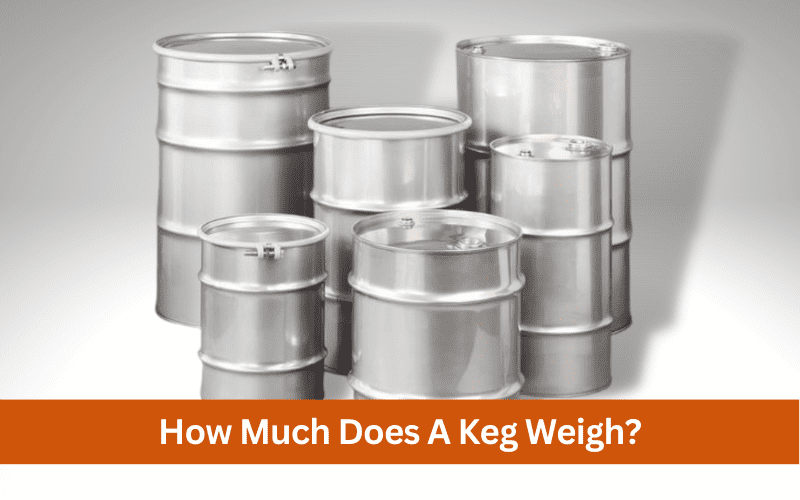Have you ever found yourself trying to lift a keg and wondering, how much does a keg weigh? As a former bartender, I’ve certainly been there. The last thing you want is to throw your back out trying to move a heavy keg, or worse, drop it and waste all that precious beer. Knowing how much a keg weighs is not only important for handling it safely, but it’s also crucial for planning events and calculating costs. In this ultimate guide, we’ll dive deep into everything you need to know about how much does a keg weigh, from how it’s measured and factors that affect it to tips for handling kegs safely and reducing environmental impact. So, grab a drink and let’s get started!
Kegs in Different Industries
Kegs are used in several industries beyond the beer industry. Here are some examples of industries that use kegs:
Beer industry
Kegs are most commonly used in the beer industry. Breweries and distributors use kegs to transport beer to bars, restaurants, and other retail locations. Kegs are also used in homebrewing, allowing beer enthusiasts to make their own beer and dispense it from kegs.
Soda industry
The soda industry also uses kegs to transport and dispense their products. Similar to the beer industry, soda manufacturers use kegs to transport soda to restaurants, bars, and other retail locations.
Wine industry
Kegs are becoming increasingly popular in the wine industry. Wineries are starting to use kegs to transport wine to bars, restaurants, and other retail locations. Wine kegs are typically smaller in size than beer kegs and are made from materials such as stainless steel or glass.
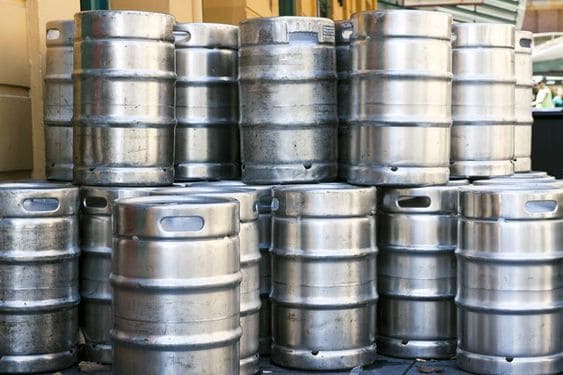
Cold brew coffee industry
Kegs are also used in the cold brew coffee industry. Cold brew coffee is often served on tap in coffee shops, and kegs are used to store and dispense the coffee. Cold brew coffee kegs are typically smaller in size than beer kegs and are made from materials such as stainless steel or plastic.
Other industries
Kegs are also used in several other industries, such as dairy and juice. In the dairy industry, kegs are used to transport and dispense milk and other dairy products. In the juice industry, kegs are used to store and dispense fresh juice.
Types of Kegs
When it comes to kegs, there are several types available in the market. Each type has unique features and characteristics that make them suitable for different purposes. Below are some of the most common keg types you’ll encounter:
Half Barrel Keg
Half barrel kegs, also known as full-size kegs, are the most common type of keg used in the beverage industry. They hold around 15.5 gallons of liquid, which is equivalent to 165 12-ounce cans of beer. Full-size kegs are typically made of stainless steel and weigh around 161 pounds when full.
Quarter Barrel Keg (Pony Keg)
Quarter barrel kegs, also known as pony kegs, are smaller than full-size kegs and are a popular choice for home parties and small gatherings. They hold around 7.75 gallons of liquid, which is equivalent to 82 12-ounce cans of beer. Pony kegs are also made of stainless steel and weigh around 84 pounds when full.
Sixth Barrel Keg
Sixth barrel kegs, also known as sixtels, are smaller than pony kegs and are commonly used in bars and restaurants. They hold around 5.16 gallons of liquid, which is equivalent to 55 12-ounce cans of beer. Sixth barrel kegs are also made of stainless steel and weigh around 58 pounds when full.
Cornelius Keg
Cornelius kegs, also known as corny kegs, are small and portable kegs that are perfect for homebrewers and small events. They hold around 5 gallons of liquid and are equivalent to 53 12-ounce cans of beer. Corny kegs are made of either stainless steel or aluminum and weigh around 55 pounds when full.

Mini Keg
Mini kegs, also known as party kegs or Bubbas, are small and convenient kegs that are great for outdoor events and picnics. They hold around 1.3 gallons of liquid, which is equivalent to 14 12-ounce cans of beer. Mini kegs are made of either stainless steel or plastic and weigh around 15 pounds when full.
Knowing the different types of kegs and their unique features can help you choose the right keg for your specific needs. From full-size kegs for larger events to mini kegs for small gatherings, there’s a keg type for every occasion.
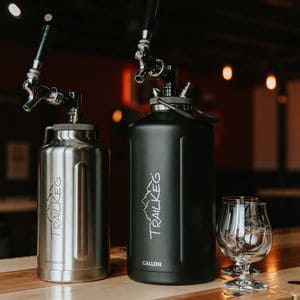
How Kegs are Measured and Weighed
Kegs are typically measured and weighed using standard units of measurement. Understanding how kegs are measured and weighed is important for several reasons, such as calculating costs, determining the amount of product remaining in the keg, and ensuring safe handling during transportation.
The standard unit of measurement for kegs
The standard unit of measurement for kegs is gallons, which refers to the volume of liquid the keg can hold. The weight of a keg varies depending on the type of keg, the material it’s made of, and whether it’s empty or full.
Methods for measuring and weighing kegs accurately
There are several methods for measuring and weighing kegs accurately, including:
- Using a scale: The most accurate way to weigh a keg is to use a scale. Simply place the keg on the scale and read the weight.
- Using a keg measuring stick: A keg measuring stick is a long, narrow metal rod with markings that indicate the volume of liquid in the keg. To use it, insert the measuring stick into the keg and read the markings to determine the volume.
- Calculating volume based on dimensions: If you know the dimensions of the keg, you can calculate its volume using a mathematical formula. For example, the volume of a cylinder (like a keg) can be calculated using the formula: V = πr2h, where V is volume, r is the radius of the keg, and h is the height of the keg.
- Using a refractometer: A refractometer is a device that measures the density of a liquid by measuring how much light is refracted through it. This method is often used in breweries to measure the sugar content of beer and determine its alcohol content, but it can also be used to measure the density of other liquids in a keg.
How Much Does an Empty Keg Weigh?
The weight of an empty keg varies depending on the type of keg and its material, shape, and size. Knowing the weight of an empty keg is important for planning and preparing for events, as well as handling and transporting kegs safely.
Average weight of different keg types when empty
The average weight of different keg types when empty is as follows:
- Full-size keg (half-barrel): 29 pounds (13 kg)
- Pony keg (quarter-barrel): 17 pounds (7.7 kg)
- Sixth-barrel keg: 14 pounds (6.4 kg)
- Cornelius keg: 9 pounds (4.1 kg)
- Mini keg: 2.5 pounds (1.1 kg)
Factors that affect the weight of an empty keg
Several factors can affect the weight of an empty keg, including:
- Material: Kegs can be made of different materials, such as stainless steel, aluminum, or plastic, which can affect their weight. Stainless steel kegs are the heaviest, while plastic kegs are the lightest.
- Shape: The shape of a keg can also affect its weight. For example, slim quarter kegs are taller and slimmer than pony kegs, which makes them easier to store, but also lighter.
- Size: The size of a keg affects its weight, with larger kegs weighing more than smaller ones.
- Wall Thickness: The wall thickness of a keg also affects its weight. Thicker walls will make the keg heavier, while thinner walls will make the keg lighter.
Knowing the factors that affect the weight of an empty keg can help you choose the right keg for your specific needs and plan for its safe handling and transportation.
How Much Does a Keg Weigh?
Kegs are used to store and transport a variety of beverages, including beer, soda, and wine. The weight of a keg is an important consideration when handling and transporting it safely, as well as calculating costs. At this point, we’ll explore how much does a keg weigh indifferent types.
How much does a full keg weigh?
A full-size keg is also known as a half keg. So, how much does a half keg weigh?
The weight of a full keg depends on several factors, such as the type of beverage it contains, its size, and the material it’s made of. Generally, a full keg of beer or soda, such as a full-size keg (half-barrel), weighs around 160-170 pounds (73-77 kilograms). However, the weight of other keg types when full of liquid can vary, as discussed below.
How much does a corny keg weigh?
A corny keg, also known as a Cornelius keg, weighs around 55 pounds (25 kilograms) when it’s full of liquid. When empty, a corny keg weighs around 9 pounds (4 kilograms).
How much does a sixtel keg weigh?
A sixth barrel keg, also known as a sixtel keg, weighs around 58 pounds (26 kilograms) when it’s full of liquid. When empty, a sixth barrel keg weighs around 14 pounds (6.4 kilograms).
How much does a mini keg weigh?
A mini keg weighs around 15 pounds (6.8 kilograms) when it’s full of liquid. When empty, a mini keg weighs around 2.5 pounds (1.1 kilograms).
How much does a pony keg weigh?
A pony keg, also known as a quarter barrel keg, weighs around 84 pounds (38 kilograms) when it’s full of liquid. When empty, a pony keg weighs around 17 pounds (7.7 kilograms).
In summary, the weight of a keg varies depending on its size, type, and material. Knowing the weight of a keg is important for handling and transporting it safely, as well as calculating costs.
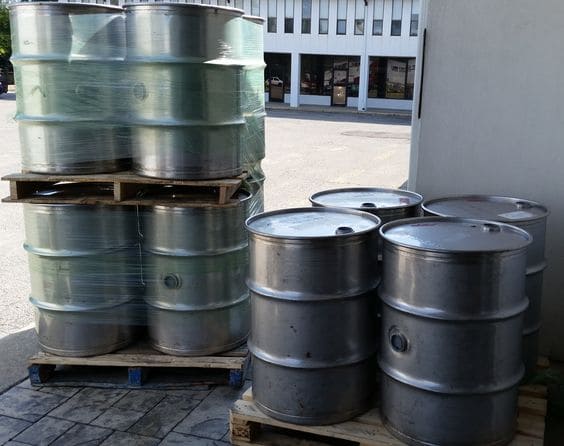
Factors Affecting How Much Does a Keg Weigh
There are several factors that can affect the weight of a keg, including:
- Material: The material a keg is made of can significantly impact its weight. For example, stainless steel kegs are heavier than aluminum or plastic kegs.
- Shape: The shape of a keg can also impact its weight. Some kegs are taller and slimmer, while others are shorter and wider.
- Size: The size of a keg also impacts its weight. A full-size keg will weigh more than a smaller pony keg.
- Wall Thickness: The wall thickness of a keg can also impact its weight. Thicker walls will make a keg heavier, while thinner walls will make it lighter.
- Type of Beverage: The type of beverage a keg contains can also affect its weight. For example, beer and soda are denser than water, so a keg containing these beverages will weigh more than a keg containing water.
- Temperature: The temperature of the liquid in a keg can also impact its weight. As the temperature of the liquid changes, it can cause the keg to expand or contract, which will affect its weight.
Knowing these factors that can affect how much does a keg weigh can help you plan for its safe handling and transportation, as well as accurately calculating costs.
Weight of Kegs Across Different Brands
Kegs come in different brands, and each brand may have its unique weight. In this section, we will look at two popular brands, Guinness and Bud Light, and their respective weights.
How much does a keg of Guinness weigh
A keg of Guinness, a popular Irish stout beer, weighs around 130 pounds (59 kilograms) when full of liquid. When empty, a Guinness keg weighs around 30 pounds (14 kilograms).
How much does a keg of Bud Light weigh
A keg of Bud Light, a popular American beer, weighs around 160-170 pounds (73-77 kilograms) when full of liquid. When empty, a Bud Light keg weighs around 29 pounds (13 kilograms).
Comparison of keg weights across different brands
Different brands may have kegs of different sizes, materials, and shapes, which can impact their weight.
For instance, stainless steel kegs tend to be heavier than aluminum or plastic kegs, and kegs with thicker walls tend to weigh more than those with thinner walls. Additionally, some brands may fill their kegs to varying levels, which can also affect the weight of the keg.
Factors that contribute to variations in how much does a keg weigh in different brands
Several factors can contribute to variations in keg weight across different brands, including the following:
- Material: Different brands use different materials to make their kegs, which can impact the weight. For example, some brands use stainless steel, while others use aluminum or plastic.
- Manufacturing process: The manufacturing process used by different brands can also impact the weight of the kegs. Some brands may use thicker or thinner walls, or different assembly techniques, which can affect the final weight of the keg.
- Quality control standards: The quality control standards used by different brands can also impact the weight of the kegs. Brands that have higher quality control standards may produce kegs that are more consistent in weight.
How to Tap a Keg
To tap a keg, you will need a keg coupler, which is a device that attaches to the keg valve and allows you to dispense the beer. Here are the steps for tapping a keg:
- Make sure the keg is properly chilled and stored upright.
- Remove the protective cover on the top of the keg valve.
- Attach the coupler to the keg valve by lining up the coupler with the valve and twisting it clockwise until it is securely in place.
- Once the coupler is attached, pull the handle or lever on the coupler to engage the valve inside the keg.
- Adjust the pressure and flow rate as needed using the regulator on the CO2 tank.
- Once the beer starts flowing, pour it into a glass or other container and enjoy!
How to Lift and Move Kegs Safely
Moving and lifting kegs can be challenging and potentially dangerous if not done properly. Here are some tips for lifting and moving kegs safely:
The proper way to lift a keg
- Begin by standing with your feet shoulder-width apart and knees slightly bent.
- Place your hands under the keg, gripping it firmly.
- Slowly lift the keg, using your legs rather than your back to do the heavy lifting.
- Keep the keg close to your body to avoid straining your arms.
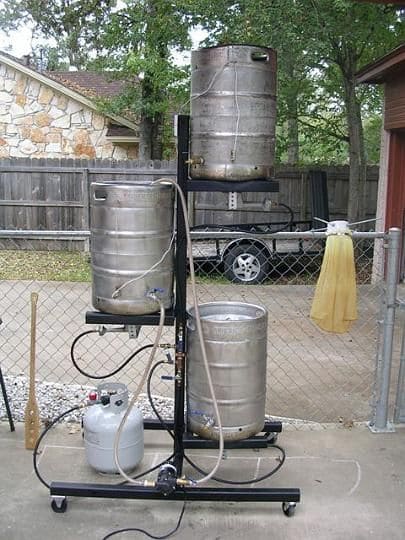
The proper way to move a keg
- Once you have lifted the keg, hold it securely against your body.
- Walk slowly and carefully, taking small steps.
- Be aware of your surroundings and avoid obstacles or uneven surfaces.
- If you need to change direction, turn your entire body rather than twisting at the waist.
Equipment to use for lifting and moving kegs safely
- Keg dolly: This is a device with wheels that is specifically designed to move kegs. It can save you from lifting the keg entirely and make the process of moving the keg easier.
- Hand truck: This is another device with wheels that can be used to move kegs. It is a good option if you need to move the keg up or down stairs.
- Lift gates: Lift gates are used to lift kegs off the ground and onto a truck or other elevated surface. They can help to prevent injuries when lifting heavy kegs.
By following these tips and using the appropriate equipment, you can lift and move kegs safely, minimizing the risk of injury.
Storing Kegs
Proper storage is essential for maximizing the lifespan of kegs and ensuring the quality of the beer inside. Here are some tips for storing kegs safely:
How to store kegs safely
- Store kegs in a clean, cool, and dry place that is free from direct sunlight.
- Avoid storing kegs in areas with excessive heat or cold, such as garages or outdoor areas.
- Ensure that the storage area is well-ventilated to prevent mold and bacteria growth.
- Store kegs upright to prevent damage to the valve and to prevent sediment from settling at the bottom of the keg.
- If storing multiple kegs, stack them no more than three high to prevent damage to the bottom kegs.
Ideal temperature and environment for storing kegs
- The ideal temperature for storing kegs is between 35-38°F (1.6-3.3°C).
- Avoid storing kegs in areas with temperature fluctuations, such as near doors or windows.
- The ideal humidity for storing kegs is between 50-70%.
Tips for maximizing the lifespan of kegs
- Use kegs within their recommended shelf life, which can vary depending on the type of beer.
- Clean kegs thoroughly before storing them to prevent bacteria growth.
- Use sanitizing solution before filling kegs to ensure that they are free from bacteria or other contaminants.
- Inspect kegs regularly for signs of damage or leaks and repair or replace damaged kegs promptly.
- Keep records of when kegs were filled and when they should be emptied to ensure that beer is not stored for too long.
How to Dispose of Kegs Properly
Proper disposal of kegs is important to minimize environmental impact and ensure that kegs are recycled or reused as much as possible. Here are some options for disposing of kegs properly:
Options for disposing of kegs
- Return the keg to the brewery or distributor: Many breweries and distributors will take back their kegs and either reuse or recycle them.
- Sell or give away the keg: If the keg is still in good condition, you can sell or give it away to someone who can use it, such as a homebrewer.
- Recycle the keg: Kegs are typically made of stainless steel, which is recyclable. Check with local recycling centers or scrap metal yards to see if they accept kegs for recycling.
- Donate the keg: Some organizations, such as non-profits or schools, may be able to use kegs for events or other purposes.
- Contact a waste management company: Some waste management companies offer recycling or disposal services for kegs.
Best practices for disposing of kegs
- Remove all beer and cleaning solutions from the keg before disposing of it.
- Remove any plastic or rubber parts from the keg, such as the valve or gaskets, before recycling it.
- Make sure the keg is empty and clean before recycling it to avoid contamination.
- Check with local regulations and guidelines for disposing of kegs to ensure that you are following the correct procedures.
- Always handle kegs carefully when disposing of them to avoid injury or damage to the keg.
FAQs
Do I need a license to purchase kegs?
The laws regarding keg sales and purchases vary by state and country. In some areas, a license or permit may be required to purchase kegs. It’s best to check with local authorities to determine what licenses or permits are required in your area.
Can I return a keg for a refund?
Many retailers and distributors will accept returned kegs for a refund. However, some may charge a restocking fee or require that the keg be returned within a certain timeframe. It’s best to check with the retailer or distributor before returning a keg.
Can I reuse a keg?
Kegs are designed to be reused, and many breweries and distributors will take back their kegs to be cleaned and refilled. However, if a keg is damaged or corroded, it may not be suitable for reuse and should be recycled.
Can I dispense beer from a keg without a tap system?
It is possible to dispense beer from a keg without a tap system using a hand pump or gravity-fed system. However, these methods may not be as efficient or consistent as a tap system and may affect the quality of the beer. It is recommended to use a tap system for the best quality beer and dispensing experience.
Conclusion
Understanding how much does a keg weigh and how to properly handle, transport, store, and dispose of kegs is important for anyone in the beverage industry or for those who enjoy homebrewing. Kegs are versatile containers that can be used for beer, soda, wine, and even coffee. By following best practices and guidelines for keg handling, we can ensure the safety of ourselves and others and reduce the environmental impact of keg waste. With the right knowledge and tools, we can make the most of kegs and enjoy quality beverages in a responsible and sustainable way.
I’m Chen Mina, from Vol de Nuit, who has a special passion for bartending, especially mixing wine, beer, and cooktail. Here you will find content about alcoholic beverages, I will bring you knowledge that few people know about this drink.

